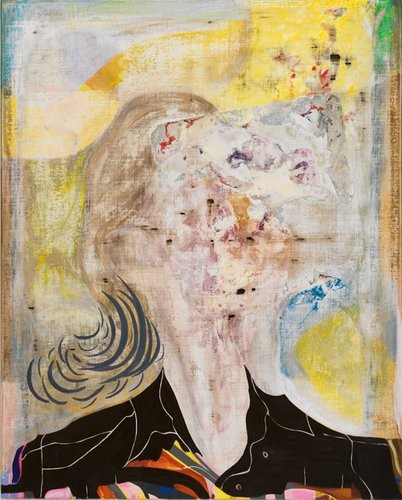Wolfgang Betke
11 Sep - 16 Oct 2010

© Wolfgang Betke
Something About Hope, 2010
Mixed media
150 x 120.5 cm / ca. 59 x 47 in.
Photo: Roman März
Something About Hope, 2010
Mixed media
150 x 120.5 cm / ca. 59 x 47 in.
Photo: Roman März
WOLFGANG BETKE
"I’d so like to be your ornamental hermit!"
Duration: 11 September – 16 October 2010
Opening: 10 September 2010, 6 – 9 PM
Location: ScheiblerMitte
Charlottenstraße 2
10969 Berlin
Wolfgang Betke's allusion to the decadentversion of the hermit as an employee on displayin eighteenth century English landscape parkssets a broader context for his first solo show atScheiblerMitte. The social role of the artist withinthe current culture industry is viewed ironically. The intense singularity of his paintings, however,leads one to suspect a critical, if not hermetic, distance to the increasing shallowness of themedia.Wolfgang Betke has been discussing this theme for years in his widely renowned spokenperformances, delivered both live and in his radio poems on OceanClubRadio, which hebroadcasted on a weekly basis.
Wolfgang Betke's paintings unite the most disparate elements. Innumerable layers ofpaint generate a series of frames from which the viewer can read the creational history of theworks. They often give the impression of combining contradictory pictorial arrangements. Betkeachieves this not least through his command of a vast range of artistic techniques: painted detailsof landscapes and scraps of clothing stand before amorphous, undulant surfaces, and paintingalla prima accentuates sweeping color gradients.
In other instances, scraps of posters or photos are worked into the picture, showing partsof a face and serving as the starting point for the reconstruction of a new visage. Their distortionand brokenness make Wolfgang Betke’s figures incomparable to the images of people producedby the mass media, but in the artist’s eyes they are more realistic than any such photographs.Aggressive deconstruction is deployed in equal measure to constructive methods. Betke sandsaway parts of his surface layers, resulting in a canvas that is extremely thin and perforated insome places. This effect is welcomed as part of the process. In these cases, decomposition in themost literal sense of the word not only affects the figure portrayed, but the painting itself. Inaddition, this action turns the artist into an archaeologist, who goes backwards in the painting'stimeline to reveal deep underlying sediment. For him, paintings are stratified time. It’s nosurprise that Betke considers the experience of duration to be an important aspect of his work.This increase in the paintings' formal and spiritual density reaches out to the viewer, who for ashort time participates in a quasi-hermetic act.
"I’d so like to be your ornamental hermit!"
Duration: 11 September – 16 October 2010
Opening: 10 September 2010, 6 – 9 PM
Location: ScheiblerMitte
Charlottenstraße 2
10969 Berlin
Wolfgang Betke's allusion to the decadentversion of the hermit as an employee on displayin eighteenth century English landscape parkssets a broader context for his first solo show atScheiblerMitte. The social role of the artist withinthe current culture industry is viewed ironically. The intense singularity of his paintings, however,leads one to suspect a critical, if not hermetic, distance to the increasing shallowness of themedia.Wolfgang Betke has been discussing this theme for years in his widely renowned spokenperformances, delivered both live and in his radio poems on OceanClubRadio, which hebroadcasted on a weekly basis.
Wolfgang Betke's paintings unite the most disparate elements. Innumerable layers ofpaint generate a series of frames from which the viewer can read the creational history of theworks. They often give the impression of combining contradictory pictorial arrangements. Betkeachieves this not least through his command of a vast range of artistic techniques: painted detailsof landscapes and scraps of clothing stand before amorphous, undulant surfaces, and paintingalla prima accentuates sweeping color gradients.
In other instances, scraps of posters or photos are worked into the picture, showing partsof a face and serving as the starting point for the reconstruction of a new visage. Their distortionand brokenness make Wolfgang Betke’s figures incomparable to the images of people producedby the mass media, but in the artist’s eyes they are more realistic than any such photographs.Aggressive deconstruction is deployed in equal measure to constructive methods. Betke sandsaway parts of his surface layers, resulting in a canvas that is extremely thin and perforated insome places. This effect is welcomed as part of the process. In these cases, decomposition in themost literal sense of the word not only affects the figure portrayed, but the painting itself. Inaddition, this action turns the artist into an archaeologist, who goes backwards in the painting'stimeline to reveal deep underlying sediment. For him, paintings are stratified time. It’s nosurprise that Betke considers the experience of duration to be an important aspect of his work.This increase in the paintings' formal and spiritual density reaches out to the viewer, who for ashort time participates in a quasi-hermetic act.
